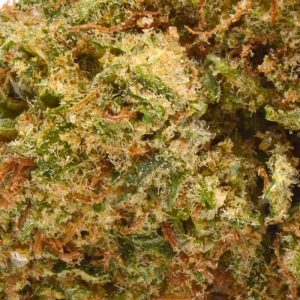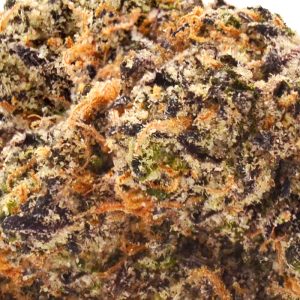Turn THCa to THC: How to Decarb THCa Flower at Home
We know that the THCa in hemp flower becomes THC when heated. But how exactly does that happen, and what’s the ideal temperature to get the best conversion?
Decarboxylation is the process of heating your THCa flower to a specific temperature to activate the THC. And trust us when we tell you it’s a really easy process to perform — in the comfort of your home.
This article covers everything you need to know to decarboxylate cannabis flower — aka convert THCa to THC. It explains the chemistry behind the transformation and all the ways you can achieve it at home.
How to Active THC: Transforming THCa into THC
The process of transforming THCa to THC is known as decarboxylation.
During decarboxylation, THCa, the acidic precursor of THC, loses the extra carboxylic group, liberates CO2, and transforms into THC.
Simply put, it’s the process of “activating” THC using heat.
If not decarboxylated, the THCa flower contains THCa in its raw form — and doesn’t have any psychoactive effects or benefits that you’ll get from using THC. Although, if you want to consume raw cannabis plant, that’s a valid point, as THCa possesses its own beneficial properties.
The decarbing process can also happen naturally for the THCa flower. Over time, as the cannabinoids in the buds are exposed to sunlight and room temperature, they start to break down naturally.
THCa is not the only cannabinoid acid to undergo decarbing — other cannabinoids go through it as well. CBDa and CBGa are the acid forms of CBD and CBG, and they also undergo decarboxylation and turn into their biologically active forms.
If decarbed for longer than necessary or left at room temperature for a longer period of time, the THC in the THCa flower starts to break down into cannabinol (CBN) and has more “sleepy” properties [1].
How Does Decarboxylation Work?
Decarboxylation is a process that happens when the cannabis flower is exposed to heat.
Cannabinoids are volatile compounds that are vulnerable to heat and high temperatures. When smoking or vaping THCa hemp flower prerolls, the direct heat decarbs the cannabinoids, making them readily available for absorption by the lungs.
The decarboxylation process begins right after the cannabis plant is harvested. Fresh cannabis buds are abundant in THCa — the biologically inactive hemp cannabinoid with no psychoactive properties. After harvest, the buds undergo drying and curing, which kick-starts the decarboxylation process.
Environmental conditions like room temperature, oxygen and light contribute to decarbing the buds. To keep the cannabinoids intact and maintain freshness and potency, you should store your THCa flower in an air-tight container in a cold, dark drawer.
Do You Need to Decarb Smokable THCa Products?
No, you don’t need to decarboxylate smokable products.
When smoking a THCa pre-roll, you are heating the cannabinoids directly through combustion. You will lose some of the THC in this process as well as inhale unconverted, raw THCa [2].
Vaporizing is an alternative to smoking because vaporizers heat but don’t burn the THCa. These devices operate at a lower and steadier temperature, which allows for a cleaner conversion of cannabinoids.
Vaping has been touted as safer than smoking because it doesn’t produce the toxins smoking does. The truth is vaping can be extremely dangerous to the lungs due to poor-quality devices, oils, and vape additives.
Decarboxylation Temperatures for THCa Flower
Heating your THCa hemp flower for 40 minutes at a temperature anywhere from 200 to 245 ºF will do the job.
If you want to make cannabis edibles, decarb the buds for 40 minutes at 220 ºF. Heating the cannabis material at this temperature for a prolonged period of time keeps the cannabinoids and terpenes intact.
Terpenes are aromatic compounds that evaporate at high temperatures. So try to avoid going over 240ºF to keep the flavors and aromas of the terpenes intact — it will create a flavorful flower for cooking.
Research shows that THCa decarboxylates faster than CBDa. This 2020 study performed by the University of Calgary has found that the reason behind this could be THCa requires less energy to make the change than CBDa, so the reaction happens faster for THCa [3].
A 2016 study showed that it takes 30 minutes for THCa to turn to THC when heated at 230ºF and 9 minutes when heated at 265 degrees Fahrenheit. On the other hand, CBDa turns into CBD within 45 minutes when heated at 230 ºF and within 20 minutes at 265 ºF [4].
Decarboxylating THCa Flower In The Oven
No, you don’t need fancy tools to decarb your THCa hemp flower.
At home, oven decarbing is the easiest and most commonly used method since every home has one of those.
The trickiest part about decarbing your THCa flower in an oven is setting the temperature. If you set the temperature too high or leave the flower in the oven for too long, you risk frying your flower.
Here are a few steps to avoid losing the active cannabinoids and terpenes when decarbing your flower:
- The oven temperature dial shows the average, not the exact temperature. Some ovens are more precise than others, and most are off by about 25-50 °F — which can result in cooking off the mark.
- To test the accuracy of your oven, you’ll need a thermometer.
- If you don’t have one, watch the flower closely. If the buds turn brown too quickly or start to smell like it’s burning, the temperature is too high and needs to be turned off or adjusted.
- The color of the THCa flower after oven decarboxylation can vary depending on the strain. So don’t overly rely on it to tell you if you’ve done a good job, especially if you’ve managed to set a steady temperature.
To decarb your THCa flower in your over, you’ll need:
- THCa hemp flower
- A grinder (optional)
- Baking sheet
- Parchment paper
- Your home oven
Instructions:
Step 1: Set the oven temperature to 240ºF because the chemical reaction begins occurring at 220 degrees. Place the oven rack in the middle position to tap into the ideal decarbing spot.
Step 2: This is the step where you grind or break up the buds. We recommend you break up the buds into tiny, even chinks using scissors instead of a grinder. Avoid breaking it down into fine powder to prevent burning.
Some people like to break down their flower with their fingers, but we don’t recommend it. You’ll lose the cannabinoids and terpenes in the process as they cling to your skin and break down.
Step 3: Place the THCa hemp flower on parchment paper or an aluminum foil pan.
Step 4: Put the pan in the oven and heat for 30 to 40 minutes. The buds should become golden brown and fill your room with an intensely pungent aroma.
Step 5: Pull the pan from the oven and let it cool for 30 minutes.
Once the flower has cooled, you can add olive oil to infuse and create a nice oil infusion for salads and dips. Or, you can store the material for future use in a storage container.
Decarb THCa Flower the Sous Vide Method
There are other ways to decarboxylate cannabis — including the sous vide method. The sous vide decarboxylation is commonly used for making cannabis products using a technique invented by French chefs.
It involves “cooking” THCa hemp flower at a specific temperature by using specific equipment. It boils the herb (yes, in a pan) that’s sealed underwater in a bag. The sous vide circulator keeps the water at a set temperature, leading to consistent “cooking” of the hemp flower.
This method won’t spread any aroma around your home, so you can try it if you want to eliminate the telltale smell.
For the sous vide decarboxylation, you’ll need an immersion sous vide circulator designed for home chefs, a plastic bag for the THCa flower immersion, and a pot with water.
Decarbing Cannabis in a Heat-Proof Mason Jar
One of the simplest methods of decarbing your THCa flower is using a mason jar.
To avoid stinking up your kitchen, replace the baking sheet and pan with a mason jar. Although this method is not 100% smell-proof, it will significantly reduce the smell.
Here’s how to transform THCa to THC using a mason jar.
Step 1: Preheat the oven to 240 degrees Fahrenheit.
Step 2: Break up the buds into very small, rice-sized, even chunks using a knife or scissors.
Step 3: Put the broken buds into the jar. You can fill up half of the jar to have room for blending or shaking the flower.
Step 4: Place the mason jar into the preheated oven and “bake” for 30-40 minutes or until the buds have turned golden brown. Every 15 minutes, give the jar a shake by holding it using oven gloves (WARNING: THE JAR WILL BE VERY HOT).
Step 5: After 30 to 40 minutes, remove the jar from the oven and set aside to cool. Once cooled, you can infuse your decarbed THCa flower in any recipe.
The mason jar will probably gather some moisture after the cooling is done. To leave moisture behind, transfer the flower to a clean, dry storage container or mason jar. Store in a cool, dark place for future use.
Have You Tried Our THCa Hemp Flower Yet?
Decarbing your flower is the easy step.
Picking the right THCa flower strain is the difficult part.
These tips will help you manage the decarbing process effortlessly. If you need high-quality, high-potency THCa hemp flower to decarb, ours is the best.
We collaborate with licensed and experienced hemp farmers that grow our THCa hemp flower organically.
Take our Pineapple OG High THCa Flower as an example.
One of our favorites, this strain is a sativa-dominant hybrid with 24+% total potency. It’s relatively rare to source because its parent strains were picked with the intent of optimizing the highest THC levels and pineapple taste possible.
Its fern green buds give a sweet-spicy pineapple aroma with notes of lemon and citrus fruits undertones. It’s already tested — it gives a flavorful and delicious fruity smoking experience. Try it out, and let us know how you liked it!
How to Calculate How Much THC is in Your THCa Flower?
Determining the amount of THC you’ll get after conversion is difficult because multiple factors are involved. Let’s take the Pineapple OG strain as an example.
The Pineapple OG strain contains 21.95% THCa and 0.3% delta 9 THC.
You can use two formulas to calculate the total THC amount that you’ll get after decarbing your flower:
Formula 1: %THC + (%THCa x 0.877)
For the Pineapple OG strain, that will be: 0.3% + (21.95% x 0.877) = 19.55%
Under USDA’s standards, total THC is calculated using this formula. The formula considers the weight percent of both THC and THCa — multiplied by 0.877 to account for the molecular weight THCa loses during decarboxylation.
This formula is not precise because it doesn’t consider the conversion of THCa.
Formula 2: (0.75 x 0.877 x %THCA) + %THC
For the Pineapple OG strain, that will be: 0.75 x 0.877 x 21.95% + 0.3% = 14.73%
Aside from the difference in molecular weight, this formula accounts for the incomplete conversion of THCa to THC. Research shows that around 75 percent of THCa will convert to THC — under ideal conditions [5].
After decarbing Pineapple OG, you’ll get approximately 14.73% total THC. Out of this amount, your body will absorb anywhere from 2% to 56% of the THC if the buds are smoked [6].
The highest amount of THC you will get from this strain is 82 mg per 1 gram of flower.
So, when calculating the total amount of THC you will get from a strain, keep in mind that incomplete conversion, direct flame, and low absorption in the body will influence the final amount of THC you’ll get.
FAQs
Should I grind the THCa flower before decarbing?
You don’t have to grind the THCa flower before decarbing.
The best approach is to break the flower into small and even pieces. If you leave larger, uneven chunks, the heat won’t decarb the material evenly.
When you grind hemp flower before decarboxylating, the heat affects the flower material evenly. This is the main perk about grinding the flower before decarboxylation.
However, ground flower may require a different decarbing time because it may burn more quickly. If you’re not being careful, you may burn the cannabinoids in the process.
If you have a pre-ground flower on your hands, you should still bake at 240°, but shorten the time for baking if necessary. Watch it closely!
Can you decarb THCa flower in the microwave?
Your microwave is not the best place to decarb your THCa flower because of poor temperature control. To decarb the flower, you need a steady temperature over a period of 40 minutes, and your oven is the best appliance for achieving those conditions.
Will I stink up my entire house when decarbing THCa flower?
Yes, the decarboxylation process will make your house smell like marijuana.
This is because baking cannabis activates and releases the terpenes that give marijuana its prominent smell. If you don’t want to stink up your place or affect your neighbor, try decarbing the buds in a mason jar or get special decarbing equipment. Please note that this won’t hold the smell entirely, but it will tame it.

























